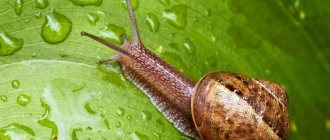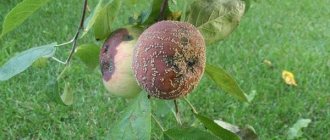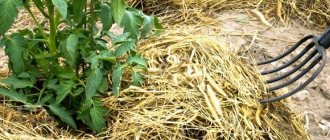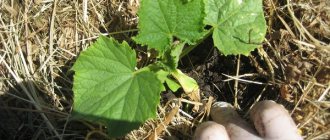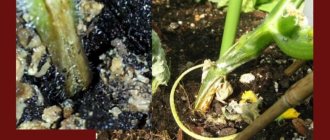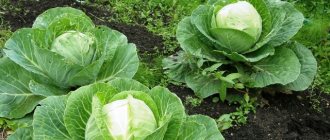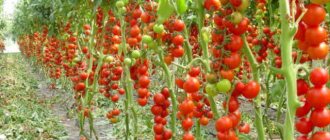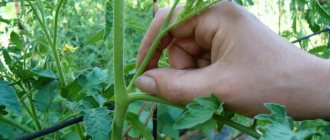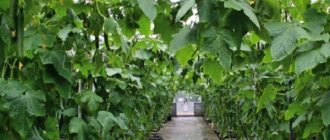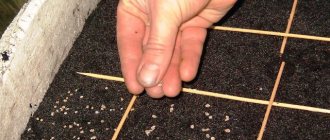What it is?
Late blight is popularly called brown rot - it is an infection of plants by microscopic fungi. This fungus can settle on the leaves, stems and tomatoes themselves.
It is worth paying attention to the appearance of the tomato; if grayish-brown spots or stripes appear on the foliage, dark brown on the trunk and brown-brown on the fruits, the plant has been affected by late blight.
Often the disease appears on the lowest tiers of foliage, gradually spreading to the entire bush. If the air humidity in the greenhouse is high, the affected areas begin to rot; as soon as the air becomes dry, the brown spots dry out.
On tomatoes, late blight manifests itself in the form of hard spots ; if not treated in a timely manner, not only the outer coverings, but also the pulp of the tomato will be affected.
This fungal disease can affect fruits that have already been removed from the bush and stored for storage. When affected by late blight, flower stalks dry out and fall off.
Photo
Below you can see a photo of late blight on tomatoes:
Folk remedies for late blight on tomatoes
How to fight late blight on tomatoes with folk remedies
Late blight on tomatoes at the very beginning of the disease can be destroyed using less radical methods such as treating the garden with fungicidal preparations. Folk remedies for treating tomatoes against late blight may not be so effective, but they are harmless to the human body. How to save tomatoes from late blight using folk remedies?
Late blight on other crops - treatment and prevention
Garlic-manganese infusion against late blight on tomatoes
You can treat them with an infusion of garlic with potassium permanganate - 100 g of garlic minced in a meat grinder (you can use not only the cloves, but also the leaves and arrows of the plant for this purpose), pour a glass of water, leave for a day, strain and, diluting this infusion in 10 liters of water, add 1 g of potassium permanganate to it.
In the photo: Tomato bush with late blight
Infusion of straw against late blight on tomatoes
Pour a kilogram of rotten hay or straw into 10 liters of water, add a handful of urea and let it brew for 3-4 days. Strain the infusion and treat the tomatoes with it.
Late blight yeast on tomatoes
Dissolve 80 g of yeast in a bucket of water and pour this solution over the tomatoes at the first symptoms of late blight.
Copper wire against late blight on tomatoes
Spraying tomatoes against late blight can be replaced by “copper piercing.” How to protect tomatoes from late blight using copper wire? The wire needs to be calcined over a fire or sanded, cut into pieces 3-4 cm long, insert such a piece into the stem of an adult tomato bush at a height of 10 cm from the soil and bend the ends of the wire down. Never wrap the wire around the stem!
- What is peat soil suitable for growing?
How to Grow Healthy Tomatoes - The Complete Guide
Some gardeners prefer to wrap pieces of copper wire around the roots of the seedlings before planting them in the garden. The fact is that microdoses of copper, enhancing oxidative processes, stabilizing the production of chlorophyll and stimulating oxygen metabolism, strengthen the plant’s immunity and make it resistant not only to late blight, but also to other infections.
Iodine for late blight on tomatoes
Everyone knows about the antimicrobial effect of iodine, so the method of spraying tomatoes with a milk-iodine composition is widely popular among gardeners. For 10 liters of water, one liter of low-fat milk and 20 drops of iodine are enough.
In the photo: What stem blight looks like
Ash solution against late blight on tomatoes
This treatment is carried out in three stages: as soon as the seedlings take root and begin to grow, before the tomatoes bloom and immediately before the first ovaries appear. Add half a bucket of wood ash to 10 liters of water and leave for three days, stirring from time to time. When the composition has settled, the liquid must be drained, its volume brought to 30 liters and 30-35 g of liquid soap added to the composition.
Serum against late blight on tomatoes
Treating tomatoes against late blight with curdled milk serum also gives good results. Dilute the serum in a one to one ratio with water and from the first days of July spray the tomatoes at least every day.
Where and when is it formed?
Late blight is quite widespread; it can appear on potatoes, tomatoes, eggplants, and cucumbers.
The affected areas are:
- weak;
- average;
- strong.
Often the disease begins to progress in the second half of summer , it is at this time that temperature changes begin, and humidity rises in the morning or evening, and it often rains. The cause of this disease may be:
- excessive application of nitrogen fertilizers;
- strong thickening of plantings;
- incorrect proximity, for example, it is better not to plant tomatoes next to eggplants and potatoes;
- rare ventilation.
Therefore, it is advisable to use preventive measures rather than wait until the disease affects the crop.
Why does it affect tomatoes?
Late blight is a fungal disease spread by spores , like all fungi. Spores can be found everywhere - in the air, in the ground, on supports and garden tools.
Fungi grow and reproduce in a humid environment, so the disease often progresses when the soil in greenhouses is very wet, especially if the tomatoes are planted densely and ventilation is done very rarely. Tomatoes belong to the nightshade family, which are susceptible to various fungal diseases. Under what conditions does late blight develop on tomatoes?
If the plants are not sprouted, there are a large number of leaves on the trunks, while access to fresh air is limited - these are favorable conditions for fungal diseases.
- Soil with a high lime content.
- Temperature changes at which dew falls on tomatoes.
- Weakened plants that lack beneficial elements.
- The use of a huge amount of nitrogenous fertilizers and organic matter.
It is worth remembering that a large amount of fertilizers that stimulate the abundant growth of greenery can also cause the spread of the disease.
As a result of selection, tomato varieties have emerged that are resistant to late blight, and among them there are varieties suitable for growing in a greenhouse, where the risk of infection increases.
Biological features of late blight
The causative agent of late blight on tomatoes is a fungus belonging to the genus Late blight. More precisely, an oomycete is a mycelial organism that is very similar in structure to mushrooms, but has a number of differences. It is believed that oomycetes appeared on Earth earlier than fungi and they can theoretically be classified as a special group.
This microorganism is called Phytophthora infestans. It can infect both tomatoes and potatoes, eggplants, sweet and bitter peppers. His homeland is Mexico. Gradually it spread throughout the world. Now cases of late blight are regularly recorded in different countries, in all corners of the Earth. Its other varieties are dangerous for grain crops and grasses. They also significantly harm the agricultural industry. Late blight infestan is dangerous due to its speed of spread, as well as its resistance to negative environmental factors.
Spores can remain in the ground for several years, withstand frost and heat, and drought. They can live in compost, on rotten logs, and not only on garden crops. They can contaminate garden tools. As soon as environmental conditions change and become favorable again, plant infection occurs.
The main differences from the simplest mushrooms:
- cell membranes are not covered with chitin, as is the case with fungi, but with cellulose - that is, they are less resistant to mechanical damage;
- the vultures are not separated by partitions and are a simpler substructure;
- the population cannot develop outside the host cells.
This makes them more vulnerable at first glance. In fact, the opposite is true. If tomatoes harvested in August and hidden in the cellar for a couple of days were infected with them, the entire crop stored for storage may soon become covered with putrefactive spots. The same goes for potatoes. In the tubers of this crop they can remain unnoticed for a long time.
Favorable environmental conditions for the development of late blight infestan are: rains for several days in a row;
- dampness;
- windy weather;
- cold snap.
It is necessary to inspect the plants in this case. Of course, not every season the disease reminds itself. But one day you will probably have to fight him. This is inevitable if crops grow on the site, the juice of which is liked by this mushroom. All nightshades, very popular and sought-after crops in gardening, are in danger.
Why is late blight dangerous?
Late blight is scary because the disease is invisible at the first stage , especially since the spores are very tenacious. They can remain dormant for a long time on the greenhouse structure, in the ground, and even on plant seeds. Spots appear on the tomatoes themselves, which gradually spread to the entire fruit, while it becomes deformed and begins to rot.
During decay, a sharply unpleasant odor appears. If the disease spreads, you can lose up to 70% of the tomato harvest.
How to detect?
The spores of this fungal disease spread very quickly; they can get on tomatoes with gusts of wind; a person can bring them into the greenhouse on clothing, for example from potato tops. The incubation period in a humid environment is 3-15 days.
- Often the initial stage of development of late blight goes unnoticed, since the time period for the development of the disease is in a large time interval.
- Gradually, the plant begins to become covered with brown spots, which spread very quickly throughout the bush.
- If the humidity in the greenhouse is high, then at the initial stage you will notice a small white coating similar to fluff on the stems and the inside of the leaves.
Tomatoes get late blight from infected plants nearby. If late blight appears on potatoes, then in less than a month this disease will appear on tomatoes.
As soon as prolonged rains begin, lasting more than 2 days, you need to monitor the tomatoes, since it is in this situation that the disease begins to multiply quickly. Also, the difference between day and night temperatures is 8 degrees, then heavy dew begins to fall - the humidity increases and thereby the spores enter an atmosphere favorable for growth and development.
How to fight?
The first thing you need to understand is that late blight develops only in a humid environment , and if you take preventive measures, the disease may not appear at all. But if late blight has already affected tomatoes, then measures must be taken immediately:
- use chemical and biological preparations aimed at combating fungal diseases;
- There are many traditional ways to combat the disease.
Tomatoes should be sprayed only in warm, clear weather, at least 5 times a season. During cultivation, a special complex of fertilizers must be added to the soil, which increase the plant’s immunity.
Watch a video about the fight against late blight:
Varieties resistant to late blight
There are no completely immune varieties. Hybrids exhibit relative stability:
- Lark;
- La-La-Fa;
- Union 8 and many others.
Resistant varieties are also infected with late blight, but later than others. In addition, they are able to recover from the disease if infected leaves are removed from them and sprayed with a systemic preparation.
Preventive measures
As you know, it is better to prevent a disease than to get rid of it . What to do to prevent late blight from affecting tomatoes?
- The basic rule is that there should be nothing unnecessary on the bushes. Leaves and shoots are removed without much pity.
- Constant long-term ventilation so that the humidity in the greenhouse is normal.
- Tomato bushes need to be watered only in the morning, since during the day all the moisture will be absorbed into the ground, which will not allow it to fall out in the form of dew the next morning.
- It is important to plant plants correctly, for example, if nightshades were planted in a greenhouse, then a different type of plant should be planted the next season.
The distance between bushes should be optimal - late blight quickly spreads in dense plantings.
- Before planting plants in a greenhouse, it is advisable to treat the structure, since it is likely that late blight spores remain on the elements of the greenhouse.
- As soon as air humidity increases, preventive spraying with folk remedies or chemicals should be carried out.
To prevent late blight, you can use time-tested folk recipes.
- If you dilute 15 drops of iodine and 1 liter of milk with a minimum percentage of fat in a bucket of water, you will get an excellent, effective product for spraying tomato seedlings.
- You can also dilute a liter of kefir in 10 liters of water and leave it to infuse for 48 hours, you will get a solution that will kill all phytophthora spores. If you approach the prevention of late blight correctly, this disease will not threaten the harvest.
Important! Late blight is very difficult to remove from a site once it has settled on it, so prevention must be carried out constantly.
In addition, it is not advisable to constantly use only chemicals , since spores quickly adapt; the most optimal would be to alternate traditional methods of combating diseases and chemical ones.
Video about methods of controlling and preventing late blight:
Prevention measures
The source of infection can be affected potatoes and eggplants. These crops should not be adjacent to tomatoes. To disinfect the soil after harvesting tomatoes, rye is sown. In spring, sprouts of winter cereals are embedded in the soil.
When night temperatures drop to +10°C, preventive treatment of tomatoes against late blight with biological preparations and folk remedies is carried out. It is recommended to treat only affected tomatoes with chemicals and antifungal solutions.
Mass pruning of leaves and shoots is carried out. Plantings are thinned out as much as possible to provide the plants with the necessary ventilation. The soil is cleared of weeds, mulched with dry peat or covered with straw. When morning dew appears, reduce watering.
In open ground, the soil near the trunks is covered with old newspapers to absorb excess moisture. Stop organic and mineral fertilizing.
